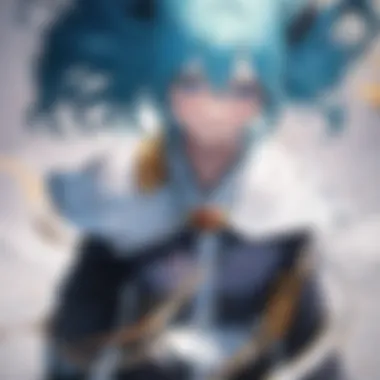Which Anime Protagonist Reflects Your Personality?


Intro
Anime offers a vast landscape of storytelling, filled with characters who reflect diverse personalities and values. Readers who engage with this medium often find themselves identifying closely with certain protagonists. Understanding these character archetypes not only enhances the viewing experience but also provides insight into the viewers’ own identities. This article delves into the intriguing world of anime protagonists, revealing how they are shaped by cultural contexts and universal themes. By analyzing different archetypes, we aim to help readers uncover which protagonist resonates most with their personality or beliefs.
Featured Series or Manga
Within the anime cosmos, various series emerge that exemplify the richness of character development. Classic shows such as Naruto and Dragon Ball Z are not only beloved for their engaging plots but also for their well-defined characters. Contemporary works like My Hero Academia and Demon Slayer continue this tradition while introducing fresh themes and challenges faced by protagonists.
Overview of the Series
Each of these series lays the groundwork for exploring the protagonist’s journey. Naruto focuses on a young ninja striving for recognition and acceptance, while My Hero Academia presents a world where society values superpowers, pushing its heroes to develop their abilities further. Both demonstrate personal growth against a backdrop of societal expectations.
Key Characters and Development
- Naruto Uzumaki: His journey from an outcast to a hero showcases resilience and the importance of friendship.
- Goku: A quintessential representation of growth through hard work and perseverance.
- Izuku Midoriya: His character arc addresses themes of ambition and self-acceptance despite insecurity.
- Tanjiro Kamado: Demonstrates compassion in the face of adversity, marking a shift in traditional heroism.
These characters deliver profound life lessons and engage audiences on multiple levels. Their fluctuating dynamics and evolving motivations reflect personal struggles that many can relate to.
Character Analysis
To truly grasp the essence of each protagonist, one must consider their character arcs and development throughout their respective series.
Major Characters
Each anime features a range of notable characters that contribute to the overall narrative. Here are key protagonists:
- Naruto Uzumaki: His early years were filled with loneliness, but he evolves into a confident leader.
- Son Goku: A fighter with a pure heart, he embraces challenges and embodies the spirit of determination.
- Izuku Midoriya: His journey from quirkless youth to a talented hero illustrates the value of tenacity and determination.
- Tanjiro Kamado: Reflects kindness and the importance of family, overcoming immense trials.
Character Arcs and Growth
Each character’s evolution is significant and multifaceted. Naruto learns the value of teamwork and forgiveness; Goku seeks not just power, but knowledge and growth. Both navigate their worlds while consistently striving for improvement, inspiring countless fans along the way.
Thematic Exploration
The diverse range of anime protagonists leads us to examine the core themes and cultural influences that shape them. The journeys of these characters often echo broader societal messages.
Main Themes and Messages
Many anime series encompass common thematic elements such as friendship, perseverance, and self-discovery. These themes resonate with audiences, encouraging them to reflect on their personal journeys.
- Friendship: Characters often rely on their companions to navigate challenges.
- Perseverance: Many stories feature protagonists who tirelessly work toward their goals in the face of adversity.
- Identity: A journey of self-discovery resonates as characters overcome obstacles that reveal their true selves.
Cultural Context and Influences
Cultural nuances significantly inflect the development of these protagonists. Societal values, historical influences, and contemporary issues often mold the characters’ motivations and growth trajectories. Shows created during times of change frequently reflect these shifts in societal norms through their narratives. This cross-cultural influence enriches the viewing experience, providing deeper connections between characters and audiences.
"By examining the diverse range of anime protagonists, we gain insights into our values, struggles, and hopes. Each character embodies traits that we can recognize within ourselves."
Prolusion to Anime Protagonists
Anime protagonists serve as the heart of narratives within this unique medium. Understanding these characters provides insights into the themes and cultural contexts embedded in various stories. Protagonists can deeply influence how audiences perceive the plot as well as how they relate to the characters' journeys.
Some might argue that the protagonist’s role is just to push the plot forward, but it is much more complex. Character evolution, motivations, and struggles often mirror societal issues and personal dilemmas. Engaging with these characters enables viewers to explore their psychology and motivations, making the experience more immersive.
By dissecting the characteristics of different protagonists, we can gain perspective on our own identities and values. This article highlights the importance of these protagonists, exploring the archetypes that define them and how they resonate with audiences. Recognizing which protagonist aligns with one's personality or life experiences can be a catalyst for personal reflection and growth.
Understanding Protagonists in Anime


Protagonists in anime often embody a variety of traits that resonate psychologically with audiences. They are not only vehicles for the story but also reflections of human emotions and societal archetypes. Characters like Naruto Uzumaki or Light Yagami illustrate contrasting paths, where resilience and ambition lead to growth but can also lead to moral ambiguity.
The exploration of protagonists goes beyond mere entertainment. It unveils the complexities of human nature as depicted through animation. Each character brings their own stories, struggles, and triumphs, allowing viewers to connect on deeper levels. Thus, protagonists are significant not only for their roles in narratives but also for their representation of diverse human experiences.
The Role of Protagonists in Storytelling
The protagonist is central to storytelling, driving the plot and engaging the audience. Their actions and decisions crucially shape the narrative arc. Anime, in particular, explores multidimensional characters who confront internal and external conflicts.
A protagonist's journey mirrors the trials of real life, connecting viewers emotionally through shared experiences.
In narratives, protagonists often face obstacles that challenge their beliefs. This helps develop not only their personality but also the central themes of the story. For instance, in "Attack on Titan," Eren Yeager's transformation from a naive boy to a formidable figure reflects the quest for freedom and the consequences of war.
The effectiveness of a protagonist hinges on relatability. A well-crafted character evokes empathy, forging a bond with viewers. As such, understanding their role is essential in appreciating the depth and narrative structure of anime, leading to a richer viewing experience.
Character Archetypes Defined
Understanding character archetypes is crucial in the realm of storytelling, especially within anime. These archetypes help viewers relate to characters and their journeys. They provide a framework that allows audiences to identify with stories on a deeper level. This section delves into what archetypes are and the common types found in anime, focusing on their significance in both character development and narrative progression.
What Are Archetypes?
Archetypes are universally recognized symbols or patterns that embody specific traits and roles. They are a way to categorize characters based on their behaviors, motivations, and development arcs. This categorization simplifies the comprehension of complex characters and their interactions in various narratives.
In literature and film, archetypes create familiarity. Audiences have pre-existing notions that guide their expectations. This can foster a sense of comfort or anticipation when watching a series. For anime, which often explores elaborate plots and fantastical worlds, archetypes serve as a stabilizing force for viewers trying to navigate through intricate stories.
Common Archetypes in Anime
Analyzing archetypes in anime reveals several recurring characters that resonate strongly with audiences. Each of these archetypes contributes uniquely to the storytelling landscape.
Hero
The hero archetype is central to many anime narratives. Heroes often embody qualities such as bravery, determination, and a sense of justice. Their journeys frequently involve personal sacrifice and growth that inspire viewers.
A notable aspect of the hero is their ability to rally others and drive the plot forward. For instance, characters like Naruto Uzumaki from Naruto exemplify resilience and hardworking spirit, making them relatable figures. The heroic journey often fosters a strong emotional connection with the audience, promoting an aspirational perspective. However, the hero may sometimes face challenges that test their ideology and resolve.
Antihero
The antihero is another compelling archetype in anime. Unlike traditional heroes, antiheroes often display morally ambiguous traits. They may act for self-interest rather than a noble cause, leading to complex narratives.
Characters like Light Yagami from Death Note demonstrate this archetype's allure. Their decisions can provoke moral dilemmas for the audience, prompting deeper reflection on justice and morality. This complexity makes the antihero a popular choice, providing a different lens through which stories can be interpreted. However, their actions might alienate some viewers who prefer clearer-cut distinctions between good and evil.
Comic Relief
Comic relief characters provide humor and lighten the mood in oppressive or tense scenarios. Their contributions are vital for balancing the emotional weight of the narrative.
For instance, Kon from Bleach acts as comic relief, using humor to contrast the darker elements of the story. Such characters can create memorable moments that break tension, enhancing the overall viewing experience. However, too much reliance on comic relief may undermine serious themes, leading to a less impactful story.
Throughout this exploration of archetypes, one can observe that they provide structural integrity to anime narratives. These character types are not merely roles; they reflect the diverse facets of human experience, offering insights into values, challenges, and interpersonal relationships. Examining these archetypes serves as a guide for viewers to understand not only the stories themselves but also their personal connection to the characters.
Iconic Anime Protagonists
Iconic anime protagonists play a critical role in drawing viewers into the story. They embody various archetypes that reflect societal values and personal aspirations. By exploring these characters, one gains insight into how narratives resonate with audiences and the cultural context from which they arise.
The importance of these protagonists extends beyond mere entertainment. They influence emotional connections and shape viewer perceptions. Through their struggles, triumphs, and evolution, these characters often become vehicles for personal reflection, prompting audiences to see parts of themselves represented in these fictional lives. This connection fosters a richer viewing experience, making the journey of the protagonist not just about the plot, but about the individual growth of viewers as well.
The Reluctant Hero
The reluctant hero often starts their journey with doubt or a desire to avoid responsibility. Characters like Shinji Ikari from Neon Genesis Evangelion exemplify this archetype well. Their internal conflicts and hesitation make them relatable to viewers who face uncertainty in their own lives. These characters typically undergo a transformation, growing in resolve as circumstances push them toward heroism. This evolution resonates deeply with anyone who has ever struggled to accept their own potential.


The Strong but Silent Type
Silent protagonists like Levi Ackerman from Attack on Titan often intrigue viewers with their stoic nature. They do not speak much, yet their actions convey strength and depth. This archetype represents the idea that sometimes words are unnecessary to express one's resolve or dedication. Their presence commands respect, and they often serve as a pillar of strength for other characters, providing a contrasting dynamic within the story. By observing this type, audiences may reflect on the complexities of strength and vulnerability in their own lives.
The Overconfident Antihero
These characters, such as Light Yagami from Death Note, challenge traditional notions of heroism. Their confidence can border on arrogance, leading them to make morally ambiguous decisions. The overconfident antihero embodies complexity, demonstrating that not all protagonists are inherently good. They captivate audiences because they provoke thought about justice, power, and personal philosophy. This exploration prompts viewers to question the nature of right and wrong and reflects their own struggles with moral ambivalence.
The Unassuming Underclassman
Often overshadowed by more dominant characters, the unassuming underclassman, represented by characters like Izuku Midoriya from My Hero Academia, demonstrates that true strength can emerge from unexpected sources. Initially seen as weak or unremarkable, these characters tend to rise through hard work and determination. This archetype resonates particularly with viewers who feel overlooked or underestimated in their own lives, highlighting the potential for growth and success despite external doubts.
In sum, iconic anime protagonists serve as mirrors, reflecting individual traits, cultural shifts, and personal aspirations. By studying these characters, viewers enhance their understanding of both the narratives and themselves.
Cultural Context of Protagonists
Understanding the cultural context of anime protagonists is crucial for two main reasons. First, it allows us to see how these characters mirror or challenge societal norms. Secondly, it provides insights into the evolution of storytelling in anime. Characters do not exist in a vacuum. They represent the values, struggles, and aspirations of the societies from which they emerge. Analyzing the cultural backdrop makes it easier to comprehend the complexities of these characters and their narratives.
Anime as a Reflection of Society
Anime often reflects issues pertinent to Japanese society, ranging from family dynamics to social pressures. For instance, the portrayal of the "Salaryman" archetype speaks volumes about the work culture in Japan, highlighting themes such as dedication, struggle, and often, the loss of personal identity.
Moreover, anime has given way to more diverse societal narratives. Characters such as Izuku Midoriya from My Hero Academia or Tanjiro Kamado from Demon Slayer exemplify the ideals and conflicts of modern youth. Their struggles are not limited to battling villains; they grapple with personal growth and moral dilemmas that resonate with viewers, especially the younger generation.
"Anime serves as a mirror, reflecting both the triumphs and tribulations of society at large."
This duality is important. While many protagonists are undeniably aspirational, they are also flawed, making them relatable. Protagonists, such as Shinji Ikari from Neon Genesis Evangelion, show emotional complexities that reflect societal mental health issues. By identifying with these characters, viewers can connect with the deeper societal commentary embedded within the storyline.
The Evolution of Protagonists in Modern Anime
The landscape of anime has changed significantly over the years. Early protagonists often followed clear archetypes, serving as archetypal heroes or straightforward antiheroes. But in recent years, there has been a rise in multidimensional characters. Modern stories depict protagonists with intricate backstories and motivations.
For example, the character of Light Yagami in Death Note begins as a typical student who believes he can rid the world of evil. Over time, his journey becomes a complex moral exploration, blurring the lines between hero and villain. This evolution is indicative of a broader trend—characters are increasingly being portrayed in shades of gray rather than in black and white.
Several social changes have influenced this shift:
- Globalization: As anime reaches international audiences, creators are inspired by diverse storytelling styles.
- Technological Advancements: Improved animation techniques allow for more nuanced character expressions, reflecting a broader range of emotions.
- Cultural Shifts: Issues such as gender identity, mental health, and societal alienation find new voice through protagonists who face relatable challenges.
The evolution of these character archetypes not only reflects changes in societal attitudes but also presents an opportunity for viewers to engage with various themes on a deeper level. This analytical approach fosters a more profound understanding of both the characters and the cultural context from which they arise.
Interactive Protagonist Identification
Identifying with anime protagonists holds significant importance in understanding one’s own character traits. This process facilitates a connection to the narrative, allowing viewers to experience a deeper engagement with the story. When an individual recognizes themselves in a particular anime character, it renders the viewing experience much more meaningful.
Moreover, this identification can lead to self-discovery. As viewers compare their traits with those of different protagonists, they begin to evaluate their own strengths and weaknesses. This reflective process can be enriching, offering insights into how one's personality aligns with various character archetypes.
In this section, we will explore several elements relevant to protagonist identification:
- Empathy Development: Recognizing traits in a favored character can improve empathy. This fosters understanding toward others who share similar characteristics.
- Character Growth: Viewers often aspire to the personal growth displayed by certain protagonists. This serves as a motivational benchmark for viewers in their personal lives.
- Cultural Relevance: Understanding how characters reflect specific cultural contexts can allow individuals to see their societal influences and values.
The process of identifying with anime protagonists brings forth various benefits, bridging the gap between the viewer's world and the fictional universe of the anime.
Self-Reflection and Character Traits
Self-reflection is crucial in the process of identifying with anime protagonists. By analyzing specific character traits, individuals can come to terms with their own personalities. Often, people find aspects of themselves mirrored in the characters they admire.
For instance, traits such as courage, determination, or vulnerability can resonate strongly. Anime often presents protagonists that embody these traits in various forms. Here are a few common character traits many viewers identify with:


- Courageousness: Some may see themselves in characters who face insurmountable odds.
- Resilience: Those who have faced challenges might align with protagonists who overcome adversity.
- Empathy and Altruism: Characters that prioritize the well-being of others can connect with nurturing personalities.
Through this lens, viewers not only observe the character's journey but also reflect on their own life situation. This deeper understanding can guide personal development.
Quiz: Finding Your Anime Protagonist Match
Engaging in a quiz to find your anime protagonist match can serve as a fun and insightful approach to understanding one’s character archetype. Such quizzes typically present questions designed to elicit personal preferences, values, and traits. They provide an interactive platform for self-discovery.
Here are elements commonly found in these quizzes:
- Personality Questions: Assessing preferences in conflict resolution, friendship maintenace, and decision-making can reveal similarities with particular protagonists.
- Interest Alignment: Understanding one’s interests in adventure, action, or introspective storytelling can help tailor protagonist matches.
- Values-Based Queries: Responding to questions about personal values, such as loyalty, honesty, or ambition, allows for a deeper dive into which character embodies these principles.
Upon completion, participants receive their results, often finding themselves aligned with certain archetypes. This knowledge can aid individuals in better understanding their personas while encouraging them to explore stories that resonate with those traits.
"Understanding yourself through fictional representations can illuminate paths towards personal and emotional growth."
By exploring these aspects of interactive protagonist identification, the connection to one’s personality deepens significantly, enhancing both the enjoyment and significance of anime narratives.
Impact of Protagonists on Viewers
Understanding the impact of protagonists on viewers is critical in exploring anime and its narrative techniques. Protagonists often embody core traits and philosophies central to the story's conflict and resolution. Their journeys resonate with audiences, creating emotional ties that can deeply influence viewers’ perceptions and experiences. The exploration of how these protagonists affect our lives helps clarify their role beyond entertainment.
Emotional Connections and Relatability
Anime protagonists are often designed to invoke empathy. They face struggles that can reflect real-world issues, making it easy for viewers to see parts of themselves in these characters. Such emotional connections facilitate a sense of understanding. For example, characters like Shinji Ikari from Neon Genesis Evangelion are characterized by their vulnerabilities and insecurities, which resonate with audiences who have faced similar feelings of doubt and uncertainty.
Key elements of emotional connections in anime:
- Relatable Struggles: Many protagonists endure personal battles that signify broader societal issues.
- Growth Arcs: Viewers often invest in characters through their development. Watching them evolve can inspire similar growth in our lives.
- Personal Reflections: Protagonists become mirrors, prompting us to scrutinize our identities and beliefs.
"The greatest stories are those that echo the struggles of life; finding yourself in a character can often lead to self-discovery."
Influence on Personal Development
Protagonists in anime can greatly influence personal development through both positive and negative examples. Their choices, moral dilemmas, and coping mechanisms shape the way viewers approach challenges in their own lives. Some characters embody ideal traits such as resilience, bravery, and loyalty. Seeing characters like Izuku Midoriya from My Hero Academia persist against despair provides motivation during tough times.
Considerations in personal development influenced by protagonists:
- Learning from Experiences: Viewers often take lessons from the decisions made by characters.
- Inspiration for Change: A well-crafted protagonist can ignite the desire for self-improvement.
- Understanding Consequences: Characters who face the ramifications of their actions can educate viewers about accountability.
Anime protagonists therefore have more than a superficial role; they serve as conduits for emotional engagement and self-reflection. Through their narratives, we see ourselves and learn vital lessons applicable to our lives.
The End and Reflections
In synthesizing our journey through the world of anime protagonists, it becomes clear that these characters are more than mere figments of imagination. They serve as mirrors reflecting various aspects of human nature and social dynamics. This section ties together the key elements we have discussed throughout the article, emphasizing the impact of these characters on both narrative structure and audience engagement.
Understanding the journey of protagonists in anime deepens our appreciation for storytelling. Protagonists embody a range of character archetypes that, when examined, reveal insights into cultural contexts and moral dilemmas. Their struggles, virtues, and flaws resonate with viewers, giving them an opportunity to reflect on their own experiences and values.
Summarizing the Journey of Protagonists
The development of anime protagonists can be viewed as a reflection of evolving societal norms and expectations. Classic characters often followed traditional heroic journeys, while contemporary protagonists tend to showcase multifaceted personalities. This shift highlights a growing recognition of individual complexity. Each archetype discussed in previous sections—from the reluctant hero to the overconfident antihero—illustrates distinct traits that connect with audiences in unique ways. For instance, the strong but silent type often embodies ideals of resilience and stoicism, appealing to those who value inner strength. Conversely, the comic relief character offers a lens through which viewers can explore humor amid adversity.
"Anime protagonists mirror our aspirations, struggles, and the collective human experience."
In sum, the journey of protagonists weaves a rich tapestry that resonates with viewers. Their stories capture the complexities of life, allowing us to identify pieces of ourselves within them.
Final Thoughts on Personal Connections
The exploration of anime and its protagonists invites us to engage in self-reflection. By analyzing character traits—whether we lean towards the introverted underclassman or the charismatic antihero—we can gain insights into our personalities and values. This identification fosters a deeper emotional connection, allowing us to embrace both our strengths and vulnerabilities.
Ultimately, recognizing the protagonist that aligns with us provides more than just entertainment; it offers a pathway to personal growth. As we consider our own journeys in relation to these characters, we may discover new perspectives that challenge our beliefs and expand our understanding. The profound connections formed through these narratives remind us that while stories may vary, the themes of humanity remain constant.
By understanding anime protagonists, we gain not only insights into fiction but also into ourselves. The reflection we see in these characters allows for an ongoing dialogue between the medium and the individual. As we conclude this exploration, it is beneficial to ponder who your favorite anime protagonist is and what that choice reflects about you.



